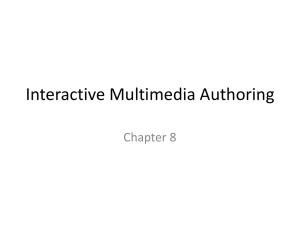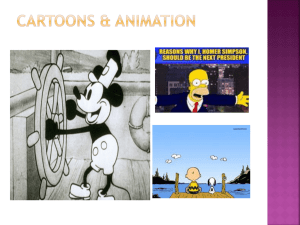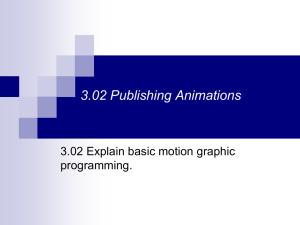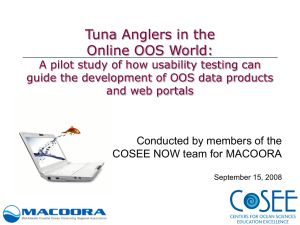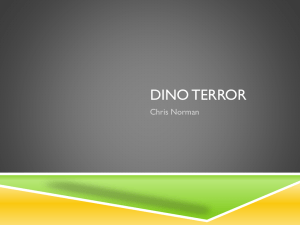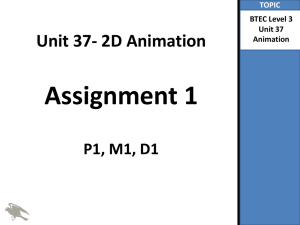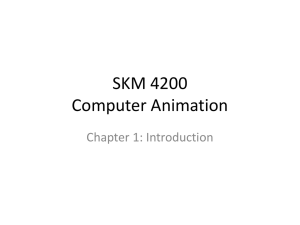Chap02-CMPD 434-Multimedia Elements
advertisement
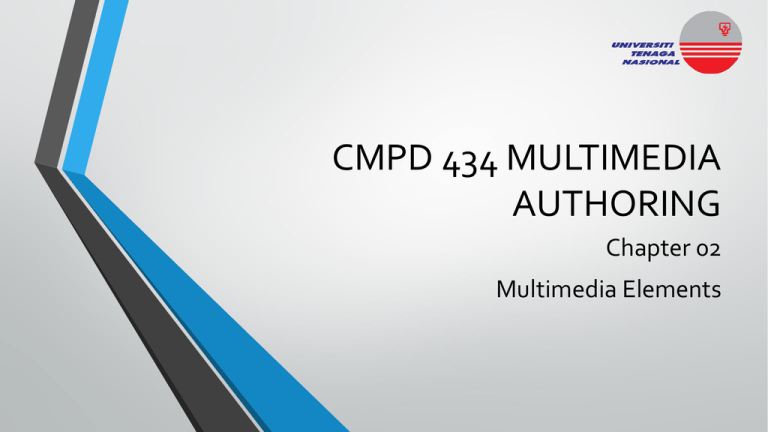
CMPD 434 MULTIMEDIA AUTHORING Chapter 02 Multimedia Elements Objective At the end of this chapter, students should be able to: • Explain and describe the 5 building blocks of multimedia and Interactivity • Examining the media elements • Understanding the various Input and Output Modalities. Five Multimedia Building Blocks and Interactivity Main Elements of Multimedia Examining Media Elements: Graphics Bitmapped VS Vector • Bitmaps images are real images that can be captured from devices such as cameras or scanners. • Vector graphics are drawn on the computer and only require a small amount of memory. Selecting the correct graphic formats • Bitmaps have two disadvantages. In terms of the amount of digital storage, bitmaps are memory intensive, and the higher the resolution, the larger the file size. • The other disadvantage with bitmaps is when an image is enlarged, the individual coloured squares become visible and the illusion of a smooth image is lost to the viewer. This 'pixelation' makes the image look coarse. • The advantages of using vector graphics are; a small file size and the ability to scale the image to any size without loss of quality. They are ideal for logo designs, as they can be printed very small on business cards or printed large on a billboard poster. • Vector graphics, however, cannot reproduce 'continuous tone' photographic images like bitmaps. Vector and Bitmapped File format/Uses DPI vs PPI • DPI - Dots per Inch This is the amount of ink dots the printer will put on each pixel of your image. The DPI is set by the actual printer device. • PPI - Pixels per Inch Digital raster images are measured in pixels, or picture elements. How many pixels per inch is determined by the device you create the digital image with: camera, scanner, or graphics software and can be modified with a photo editing software like Photoshop. • • If your image is 1993 pixels wide & printer requires 300 ppi (1993 ÷ 300) can be printed at 6.643 inches If your image is 1993 pixels wide & printer requires 240 ppi (1993 ÷ 240) can be printed at 8.304 inches Creating and editing vector and bitmapped images • Bitmap Software • • Features of painting and image-editing programs range from simple to complex across the platform. Adobe Photoshop and Lightroom remains the most widely used image-editing tool among the designer worldwide Creating and editing vector and bitmapped images • Vector Software • Adobe Illustrator or InDesign or Corel’s CorelDRAW uused to create curvy and complicated looks that they then can be convert to a bitmapped Examining Media Elements: Sound • Vibrations in the air create waves of pressure that are perceived as sound. • Sound waves vary in sound pressure level (amplitude) and in frequency or pitch. • ‘Acoustics’ is the branch of physics that studies sound. • Sound pressure levels (loudness or volume) are measured in decibels (dB). Digital audio • • Sound into a sequence of numbers, which can then be stored and read back for reproduction. Normally, the sound is transduced (as by a microphone) to an analog signal in the same way as for analog recording, and then the analog signal is digitized, or converted to a digital signal, through an analog-to-digital converter and then recorded onto a digital storage medium such as a compact disc or hard disk. Analog Audio • • • An analog recording is one where a property or characteristic of a physical recording medium is made to vary in a manner analogous to the variations in air pressure of the original sound. Generally, the air pressure variations are first converted (by a transducer such as a microphone) into an electrical analog signal in which either the instantaneous voltage or current is directly proportional to the instantaneous air pressure (or is a function of the pressure). The variations of the electrical signal in turn are converted to variations in the recording medium by a recording machine such as a tape recorder or record cutter Preparing Digital Audio Files • The first step is to digitize the analog material and recording it onto a computer readable digital media. • It is necessary to focus on two crucial aspects of preparing digital audio files: • • Balancing the need for sound quality against your available RAM and Hard disk resources. Setting proper recording levels to get a good, clean recording. Editing Digital Recordings • Multiple Tasks • Trimming • Splicing and Assembly • Volume Adjustments • Format Conversion • Resampling or downsampling • Equalization • Digital Signal Processing • Reversing Sounds • Time Stretching Synthesizer Sounds • A sound synthesizer is an electronic musical instrument that generates electric signals converted to sound through loudspeakers or headphones. • Synthesizers may either imitate other instruments or generate new timbres. • They are often played with a keyboard, but they can be controlled via a variety of other input devices, including music sequencers, instrument controllers, fingerboards, guitar synthesizers, wind controllers, and electronic drums. • Synthesizers without built-in controllers are often called sound modules, and are controlled via MIDI or CV/Gate. • A digital audio file format is preferred in the following circumstances: • • • When there is no control over the playback hardware When the computing resources and the bandwidth requirements are high. When dialogue is required. Audio File Format • A file format determines the application that is to be used for opening a file. Following is the list of different file formats and the software that can be used for opening a specific file. • • • • • • • • • • *.AIF, *.SDII in Macintosh Systems *.SND for Macintosh Systems *.WAV for Windows Systems MIDI files – used by north Macintosh and Windows *.WMA –windows media player *.MP3 – MP3 audio *.RA – Real Player *.VOC – VOC Sound AIFF sound format for Macintosh sound files *.OGG – Ogg Vorbis Examining Media Elements: Video • A video format describes how one device sends video pictures to another device, such as the way that a DVD player sends pictures to a television or a computer to a monitor. • More formally, the video format describes the sequence and structure of frames that create the moving video image. • Analog video formats • • • NTSC PAL SECAM • Digital Video Formats • • • • These are MPEG13 based terrestrial broadcast video formats ATSC Standards DVB ISDB Examining Media Elements: Animation • Animation is the art of capturing a series of individual movements, whether on film or in digital form, and replaying them in rapid succession to give the illusion of movement. • Each of the images vary slightly from its previous image. • Illusion of movement in animation is achieved by rapidly displaying many still images (or frames) in sequence. Cel Animation VS Computer Animation Traditional Animation (Cel Animation) • • Traditional animation requires cels and backgrounds to be created separately The animator draws the character in relation to the background. Each frame is drawn and then transferred onto a cel, which is a thin, transparent plastic sheet. Computer Animation • • Computer animation requires more steps. Animating a film involves modeling (a wireframe representation of the character); rigging (the "bones" of the character); texturing, layout and animation (character motion and camera moves are mapped out); lighting and shading, rendering (creating a geometric "description" of the model); and compositing (combining the elements). • Key Frames • In this technique a storyboard is laid out and then the artists draw the major frames of the animation. • Cel Animation • In this technique each character is drawn on a separate piece of opaque paper. Then, at the time of shooting animation the different characters are overlaid on top of the background in each frame. • Rotascoping • Rotascoping is a technique where images are copied from a moving video into an animation. The animator draws the motion and shape of the object by referring to the video as opposed to imagining in his head. • Computer Animation • With time the technique of animation has become more and more computer -assisted and computer- generated. All of such techniques require a trade-off between the level of control that the animator has over the finer details of the motion and the amount of work that the computer does on its own. Interactivity • Multimedia interactivity describes the set of possible actions a user can do to change the state of a multimedia system. • • • • • • • • Examining Interactivity pathways through the interactive multimedia product additional hyperlinks (internal and external) use of consistent house style use of different components interactive elements suitability for target audience purpose of interactive multimedia product ease of use Various Input / Output Modalities • To understand the evolving nature of interactive user interface, we shall first examine the human sense and their impact on our ability to create interface in relation to computer inputs/outputs. • Human Input Output Modalities • Computer Input Output Modalities

